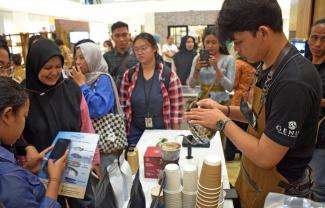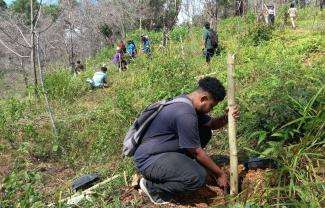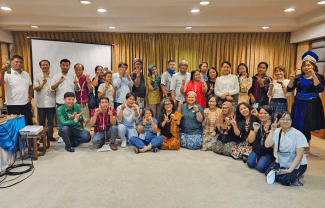The three marang trees stand sentinel over a triangular patch of land, fenced off with split bamboo. Datu Inpendingding faces the largest of the trees whose roots have already created small hollows at the base. He murmurs some words to Apu (title used for the ancestors) and buries a token of offering behind one of the gnarled roots. All first-time visitors of the Serakudang Menuvu Tribe Organization go through this ritual – to get introduced to Apu.
The Serakudang Menuvu Tribe Organization has only one protocol in their community, and it is religiously followed. They need to get the blessing of Apu for any of their undertaking. This is the essence of what has become a technical term – the Free, Prior and Informed Consent. For the Serukadang Menuvu community, they look up to the blessings of Apu for the success of their engagements. Despite the plantations of rubber, sugarcane, and other industrial crops surrounding the small community, they remain in touch with their natural environment. Their means of living is dependent on their resources, thus, their lifestyle puts value in the conservation and protection of their resources.
Securing Access to Water
Samdhana Institute supported the Serukadang Menuvu community in establishing their water system. The community, especially the women and children, greatly suffered because of the lack of access to water. The nearest source of fresh and clean water is located in the valley, about 180 meters below. The mothers narrated that it takes them about an hour to collect only around 2 gallons of water, going up and down the very steep hill. At times, the children need to collect water as well. Upon their return from laboring in the sugarcane plantations, the husbands also need to give time and energy to collect more water for their households.
In partnership with the non-government organization, A Single Drop of Safe Water, the Serukadang Menuvu community implemented the installation of their water system. The men and women actively participated, thus the construction was quickly completed within a month’s time. Community members provided labor, and the women and even the children helped in hauling the construction materials into the site, which was not passable by big trucks.
Along the way, the discrimination against the indigenous community surfaced in the delays they encountered when they asked for certifications and undertook other legal processes with the Local Government Unit. But the community, despite the small setbacks, was determined to see the success of the project.
Land Conflict
The small community, composed of 34 families, had lost control of most of their ancestral domain. Their territory had been considered government property, which was subjected to a stewardship program under the Integrated Social Forestry (ISF) program. Mostly migrants received the CBFM and ISF stewardship, and, in some cases, the land was sold to other migrant farmers, even though this is illegal. To be able to farm, each of the Serukadang Menuvu family had to apply for a stewardship agreement with the Department of Environment and Natural Resources. They continued to lose parts of their ancestral domain when they were forced to pawn off lands for emergency needs, and quite ironically, to fund the processing of their ancestral domain certificate. They had been literally pushed to the margins, where the families remained on a two-hectare parcel of land alongside the cliff. They mainly worked as sugarcane farm laborers. Whatever they could farm was mainly for their own consumption. Some produce in excess are sold to nearby communities, mostly at the schools which their children attend.
In December 2017, most of the 25-years stewardship agreements had expired, and the Serukadang Menuvu community took steps to reclaim the lands with the expired agreements, even without the formal Certificate of Ancestral Domain Title (CADT). Most of the stewardship holders and individuals who owned vast tracks of farms strongly resisted this move. The community leaders received threats. As a protest and as an assertion of their right, the community decided to till two hectares of the land. The entire Serukadang community worked hard to clear the land and prepare it for planting with corn. However, they were met with threat of violence from the settlers. One day, about a hundred men in motorcycles and trucks, accompanied with a tractor forcibly entered the tilled area and some of them started to uproot the growing corn. The community members stopped them from entering further. The community was ready to defend their land, and even their women Elder who was 90 years old went up front to block the way of the tractor. To ensure that no lives would be lost, the Serukadang Menuvu leaders let their cooler heads prevail and negotiated with the men, who eventually all pulled out. With an Urgent Action Grant from Samdhana, the Serukadang Menuvu conducted a security planning and strategized how to pursue the reclaiming of their land without aggravating the imminent threats. Among the steps they took was to invite officers of the National Commission on Indigenous Peoples (NCIP) to explain to officials of the Local Government Unit and other residents and farmers in the area about the Indigenous Peoples Rights Act.
The Serukadang Menuvu leaders spoke directly with some of the individual steward holders to negotiate a gradual process of getting back their lands. They explained that they would still respect the migrant settlers in their territory, if they also recognize and respect the rights of the Serukadang community, and will abide with their policies. They were willing to negotiate the use of lands, as they recognize that even non Indigenous Peoples needed land to survive and earn a living. Their purpose of reclaiming back the lands is only to ensure that their families could also grow food and earn income, and be recognized as the rightful owners. These efforts by a small community demonstrate that when Indigenous peoples have a good grasp of their rights, and with a little support, they are able to concretely assert their rights. Overcoming those months of threat and pressure, they literally saw the fruits of their hard work when they were able to harvest the corn, watermelons, bitter gourd, and other vegetables a few months after their collective action.




